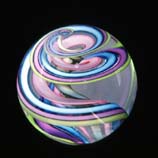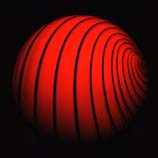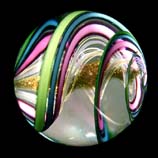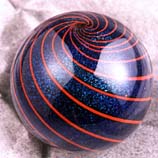
|

|

|
Handmade Glass Marbles | ||

German Spirals or Candy StripesIt is believed that the first glass marbles were made in Venice by the old Venician glassblower, which were the marbles called monstrosities by the early English. It is believed that the English had a low opinion of them because glass marbles were not sturdy enough to be useful in any of their games. The first records of glass marble production occurs in, the province of Thuringen, the principal towns of production being Lauscha and Sonneberg. The small factories were known as glass cottages, and they began producing glass marbles after a Lauscha glass cottage worker invented a new work tool in 1846 known as "Marbelschere" or marble scissors. This tool made rapid production of marbles of uniform quality possible, established the prodution of marbles for sale to the public. This created a demand for the glass swirls so great that in 1852 a new glass cottage was built mainly for the production of glass marbles, which are still being made today. Production methods have changed since World War I.
It is believed by some that the first major production of handmade
glass marbles took place in the Netherlands before the Thuringen region
began production. Just after World War I, marbles production by a
half-automatic machine began. The machines were invented in America
during World War I, forcing handmade marble companies out of business
following the war.
| ||
| * * * | ||
Early American Glass MarblesThe Iowa City Flint Glass Manufacturing Company was founded on April 30, 1880, by J.H. Leighton, and was only in operation for fifteen to twenty months, failing in 1882. There is one marble in the Iowa City Historical Museum which can be described as having a diameter of about 1 1/2 times that of a silver dollar, with four swirling bands alternating red, white, green, and white. Sulphides with figures of animals and birds are said to have beenproduced. Mr. Leighton was also involved in other glass companies prior to and following theexistence of the Iowa City factory, making it possible for marbles of this type to be produced by other companies.The Navarre Glass Marble Company of Navarre, Ohio, operated by Emil Converse, supposedly produced both spiral and sulphide types like those made in Germany. The Boston and Sandwich Company in Massachusetts also produced glass marbles. Old factoy sites have been excavated uncovering a considerable number of the marbles in a broken or imperfect condition. Though it is belived by some that these marbles may have been imported, evidence proves that is it highly unlikely. It is, however, more likely that the the colored canes from which the marbles were made were imported.
| ||
|
* * *
Song: "Battle of New Orleans"
| ||
 Glass marbles were made from glass rods or canes made with a blowpipe 26
cm or 10" thick to roll a clear glass mass approximately six inches
long. Hot glass rods of various colors were placed in the grooves of a
6"-long iron sheet. The clear glass bar would then be rolled over the
sheet, picking up the colored rods in the grooves. Rods placed in
consecutive grooves on the sheet produced a solid column in the marble.
Rods separated from each other by one or two grooves produced an open
swirl effect. Then the bar would be covered with clear glass and if
another ring of colored rods was desired in the marble, the process
would be repeated. When the desired pattern was achieved, the bar was
pulled and twisted to a diamter of 1 1/2" to 2 1/2" and a length of
approximately 6 1/2 feet. Bars would be prepared in advance and eight
to twelve bars would be stored in an oven until the glassblower was
ready to cut marbles. The rods might be reheated, pulled and twisted
to make marbles of smaller diameter, or they might be used as they were
for larger marbles.
Glass marbles were made from glass rods or canes made with a blowpipe 26
cm or 10" thick to roll a clear glass mass approximately six inches
long. Hot glass rods of various colors were placed in the grooves of a
6"-long iron sheet. The clear glass bar would then be rolled over the
sheet, picking up the colored rods in the grooves. Rods placed in
consecutive grooves on the sheet produced a solid column in the marble.
Rods separated from each other by one or two grooves produced an open
swirl effect. Then the bar would be covered with clear glass and if
another ring of colored rods was desired in the marble, the process
would be repeated. When the desired pattern was achieved, the bar was
pulled and twisted to a diamter of 1 1/2" to 2 1/2" and a length of
approximately 6 1/2 feet. Bars would be prepared in advance and eight
to twelve bars would be stored in an oven until the glassblower was
ready to cut marbles. The rods might be reheated, pulled and twisted
to make marbles of smaller diameter, or they might be used as they were
for larger marbles.  Then marbles would be cut off the glass rods by the marble scissors,
which were hand crafted consisting mainly of a strip of iron in the
shape of a "U," resembling a pair of tongs. A round bottom cup was on
the right hand end and and a knife-like blade on the left The marble
bowl or cup was attached only with a screw which allowed cups of
different sizes to be attached. The glassblower would press the hot
end of the glass bar into the cup with enough pressure to round the end,
close the blade while twisting the bar slowly. Once the spheres became
somehwat hardened, they would beplaced in a churn-shaped wooden barrel
which was kept in continuous rotation by the marble maker helping to
shape the glass pieces into marbles. Then the marbles were picked up
with an iron spoon, placed in an annealing oven in lots of ten to twenty
to cool. Several marbles could be cut from a cane before the glass bar
had cooled to the point where it required reheating. Once the marbles
were cooled, they were polished.
Then marbles would be cut off the glass rods by the marble scissors,
which were hand crafted consisting mainly of a strip of iron in the
shape of a "U," resembling a pair of tongs. A round bottom cup was on
the right hand end and and a knife-like blade on the left The marble
bowl or cup was attached only with a screw which allowed cups of
different sizes to be attached. The glassblower would press the hot
end of the glass bar into the cup with enough pressure to round the end,
close the blade while twisting the bar slowly. Once the spheres became
somehwat hardened, they would beplaced in a churn-shaped wooden barrel
which was kept in continuous rotation by the marble maker helping to
shape the glass pieces into marbles. Then the marbles were picked up
with an iron spoon, placed in an annealing oven in lots of ten to twenty
to cool. Several marbles could be cut from a cane before the glass bar
had cooled to the point where it required reheating. Once the marbles
were cooled, they were polished. Several methods were used to polish the marbles, one method consisting
of fire polishing the marbles, or reheating them until the glass became
soft again. An acid polish might be used, where the polish would be
produced by dipping the marbles into an acid solution. A dull polish
could be obtained by tumbling the marbles in large rotating metal drums
containing a mixture of water and a polishing compound, which is used
today for polishing small gem stones.
Several methods were used to polish the marbles, one method consisting
of fire polishing the marbles, or reheating them until the glass became
soft again. An acid polish might be used, where the polish would be
produced by dipping the marbles into an acid solution. A dull polish
could be obtained by tumbling the marbles in large rotating metal drums
containing a mixture of water and a polishing compound, which is used
today for polishing small gem stones.